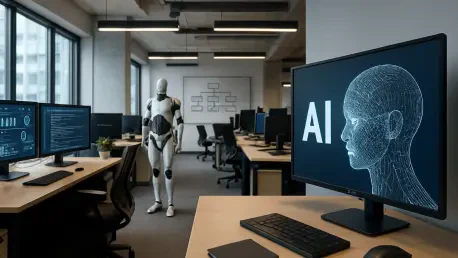In today’s fast-paced world of technological advancement, artificial intelligence (AI) is fundamentally changing the way businesses operate, streamline processes, and envision growth, yet a crucial department—Human Resources (HR)—is frequently left on the sidelines of strategic discussions. Despite HR’s deep understanding of workforce dynamics, employee morale, and talent development, many organizations exclude HR leaders from the critical early stages of AI implementation. A recent comprehensive report from Beamery, an HR data vendor, sheds light on this troubling trend, revealing how such oversight could undermine the potential benefits of AI. The disconnect between HR’s capabilities and their actual involvement raises pressing questions about how companies can fully harness AI while addressing the human elements at the core of any successful transformation. This gap not only risks misalignment with business goals but also threatens employee engagement and long-term sustainability.
Uncovering the Gap in HR’s Role
The reality of HR’s involvement in AI transformation paints a stark picture of misalignment within corporate hierarchies. A significant portion of C-suite executives assert that HR is included from the outset of AI initiatives, yet a much smaller percentage of HR leaders corroborate this claim, exposing a profound disconnect in perception. Even more concerning, when asked to identify key decision-makers in AI projects, only a tiny fraction of respondents point to Chief Human Resources Officers (CHROs) as influential, dwarfed by the recognition given to CEOs and technology leads. This marginalization suggests that many organizations are prioritizing technical implementation over the human factors that HR is best equipped to address, potentially leading to strategies that fail to resonate with the workforce or support broader objectives. The numbers speak volumes about a systemic issue where HR’s voice is muted at a time when it is most needed to navigate the complexities of technological change.
Beyond the statistics lies a deeper challenge of communication and priority within leadership circles. The discrepancy between how executives view HR’s role and the reality experienced by HR professionals indicates a lack of alignment on strategic goals. This gap often stems from a tendency to view AI as a purely technical endeavor, relegating HR to a reactive rather than proactive position. As a result, critical decisions about automation and workforce impact are made without the nuanced perspective that HR brings regarding employee needs and organizational culture. Such exclusion can lead to initiatives that, while technologically sound, miss the mark on fostering employee buy-in or addressing potential resistance. Bridging this divide requires a cultural shift within organizations to recognize HR not as a peripheral function but as a central pillar in shaping AI-driven transformations that balance innovation with human-centric values.
HR as a Strategic Asset in AI Planning
Imagine a scenario where AI strategies are crafted with workforce implications at the forefront—this is where HR’s untapped potential shines. HR leaders possess the expertise to pinpoint which tasks can be automated without eroding employee satisfaction or customer outcomes, ensuring that technology serves as an enabler rather than a disruptor. They can also guide the transition of employees into higher-value roles, fostering skill growth and aligning these shifts with long-term business visions. When excluded from early discussions, however, the risk of overlooking critical skill gaps or disengaging employees grows significantly. HR’s strategic input could be the linchpin that ensures AI not only boosts efficiency but also nurtures a motivated, adaptable workforce ready to embrace change. Without this perspective, companies may find their AI investments falling short of delivering meaningful, sustainable impact across the organization.
Moreover, HR’s role extends beyond immediate implementation to shaping a future-ready workforce through targeted upskilling programs. By understanding the evolving demands of AI-integrated roles, HR can design training initiatives that prepare employees for new challenges, reducing anxiety around job displacement. This proactive approach helps maintain morale and positions the organization as a leader in employee development, a key factor in talent retention. When HR is sidelined, these opportunities for alignment and growth are missed, often resulting in reactive measures that fail to address underlying concerns. Integrating HR into the planning phase allows for a holistic strategy where technological advancements and human capital development go hand in hand, creating a synergy that maximizes the return on AI investments while safeguarding employee well-being and organizational harmony.
Barriers to Seamless AI Integration
Implementing AI in workplace settings is fraught with challenges that span across departments, with HR and executive leaders facing overlapping yet distinct obstacles. Many HR professionals cite a lack of clarity around employees’ day-to-day tasks as a major barrier to effective automation, making it difficult to identify processes ripe for technological intervention. This uncertainty can stall progress and lead to misaligned priorities when AI tools are deployed without a full understanding of their impact on workflows. Simultaneously, broader issues like inconsistent data quality and availability further complicate the landscape, often leaving even the most well-intentioned initiatives vulnerable to inefficiencies. These hurdles emphasize the necessity of involving HR early to provide granular insights into workforce operations, ensuring that AI solutions are both practical and impactful in real-world applications.
Employee resistance adds another layer of complexity to AI adoption, as trust in new systems is often hard-won. C-suite leaders frequently highlight concerns over selecting appropriate tasks for automation and overcoming skepticism among staff who fear job loss or diminished roles. Without HR’s expertise in change management and communication, these fears can fester, leading to reduced productivity and engagement. HR can play a vital role in crafting transparent narratives around AI’s purpose, demonstrating how it complements rather than replaces human effort. The absence of such guidance risks creating a workforce that views AI with suspicion rather than as a tool for empowerment. Addressing these multifaceted barriers demands a collaborative approach where HR’s insights into employee sentiment and operational realities inform strategies that mitigate resistance and build a foundation of trust across all levels of the organization.
Divergent Views on AI’s Workplace Effects
The impact of AI on the workplace is perceived through varied lenses depending on one’s position within the employment spectrum. Early-career employees often express a surprising optimism, viewing AI as a catalyst for personal and professional growth. Many believe it enhances their likelihood of remaining with their current employer by opening new career pathways and increasing engagement through innovative roles. This positive outlook reflects a generational openness to technology as a means of advancement rather than a threat, suggesting that younger workers see AI as a tool to redefine their contributions. However, this enthusiasm is not universal, as some still harbor concerns about job security in an increasingly automated landscape. These mixed feelings underscore the importance of tailored communication to address diverse employee perspectives on AI’s role.
In contrast, job seekers paint a more cautious picture, with a significant number expressing apprehension about AI’s potential to limit opportunities in the market. This group often worries that automation could shrink the pool of available roles, making it harder to secure stable employment in a tech-dominated future. The stark difference between the optimism of current employees and the anxiety of those outside the workforce highlights how context shapes attitudes toward AI. For organizations, this disparity signals a need to balance internal strategies with external perceptions, ensuring that AI adoption is framed as a creator of value rather than a barrier to entry. HR’s involvement could bridge this divide by advocating for policies that prioritize reskilling and transparency, addressing the fears of job seekers while reinforcing the growth opportunities that current employees value.
Addressing the Workforce Readiness Deficit
As AI continues to permeate workplace environments, a glaring trend emerges: many organizations are unprepared to equip their employees for this shift. Despite widespread enthusiasm for adopting AI technologies, a substantial number of companies lack the resources or frameworks to train staff effectively for evolving roles. This readiness gap often stems from HR’s exclusion from strategic planning, leaving workforce development as an afterthought rather than a priority. Without structured programs to build necessary skills, employees may struggle to adapt, leading to frustration and inefficiency. Experts stress that HR’s early inclusion is critical to designing initiatives that align with AI-driven changes, ensuring that staff are not only prepared but also confident in their ability to thrive amidst technological advancements. This proactive stance is essential for maintaining competitiveness in a rapidly changing landscape.
Furthermore, the absence of strategic workforce planning risks eroding employee trust and buy-in, key components of successful transformation. HR leaders can spearhead efforts to communicate the benefits of AI, addressing concerns about displacement while highlighting opportunities for growth. By fostering a culture of continuous learning, HR can help organizations turn potential disruption into a catalyst for innovation. This requires investment in accessible training platforms and partnerships with educational providers to close skill gaps. When HR is sidelined, these vital steps are often delayed or overlooked, hampering the organization’s ability to fully leverage AI. Bringing HR into the fold early ensures that workforce readiness becomes a cornerstone of AI strategy, creating a resilient and adaptable employee base capable of navigating future challenges with confidence and competence.
Reflecting on HR’s Path Forward
Looking back, the journey of integrating AI into workplaces reveals a critical oversight in sidelining HR from pivotal discussions. The stark disparities in perception between executives and HR leaders, coupled with the challenges of adoption and varied employee sentiments, underscore a missed opportunity to balance technology with human needs. HR’s exclusion often resulted in strategies that neglected workforce readiness and engagement, leaving gaps that hindered the full potential of AI. Reflecting on these lessons, it becomes evident that sustainable progress demands a shift in approach. Moving forward, organizations must prioritize HR’s strategic input from the outset, ensuring that AI initiatives are grounded in employee-centric planning. By investing in upskilling and fostering transparent dialogue, companies can build trust and alignment, turning technological advancements into a shared vision for growth and innovation across all levels.









